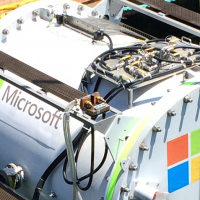Deep Dive: Microsoft Explores Ocean Data Centers

The growing popularity of cloud computing and our Internet of Things connected lifestyle means the need for data centers will surely increase—along with energy consumption. Data centers are regarded as energy hogs by many, and the hope is that renewable power sources can become a cost-effective alternative. Microsoft recently launched Project Natick to find out if data centers located under the ocean could be a viable possibility.
While much of R&D efforts focus on wind turbines or solar energy, such as the U.S. Department of Energy’s SunShot Initiative, our most abundant natural resource is water. After all, more than two-thirds of the Earth is covered by water, and the oceans hold about 96.5 percent of our water.
Microsoft is one company that believes locating at least some future data centers in the ocean and using the hydrokinetic energy from waves or tides offers intriguing possibilities. If half of the world’s population lives within 120 miles of the sea, as Microsoft states, then underwater data centers could potentially reduce latency and speed data transmission. Besides, it’s cold in the ocean, and a problem has always been cooling the data center computers to prevent overheating.
The idea for Natick was sparked from a research paper by a member of Microsoft’s Cloud Infrastructure & Operations team, Sean James, who had served in the Navy for three years on submarines, according to the Microsoft announcement. “What helped me bridge the gap between data centers and underwater is that I’d seen how you can put sophisticated electronics under water, and keep it shielded from salt water. It goes through a very rigorous testing and design process. So I knew there was a way to do that.”
Launched in August, 2015 off the California coast, the test data center was located in a round 38,000-pound container since, according to Natick Project Manager Ben Cutler, “Nature attacks edges and sharp angles, and it’s the best shape for resisting pressure.”
According to Microsoft, a diver checked on the vessel periodically, and the research team monitored remotely. The test vessel tapped into an existing electrical grid, but future possibilities include using the hydrokinetic energy from waves or tides for computing power. The structure was retrieved approximately three months later and brought back to Redmond for further testing and evaluation. Apparently, sea life adapted well to the vessel, and the company believes results look encouraging.
Project Natick is currently at the research stage, but if you’re interested, here’s a video of the launch.

